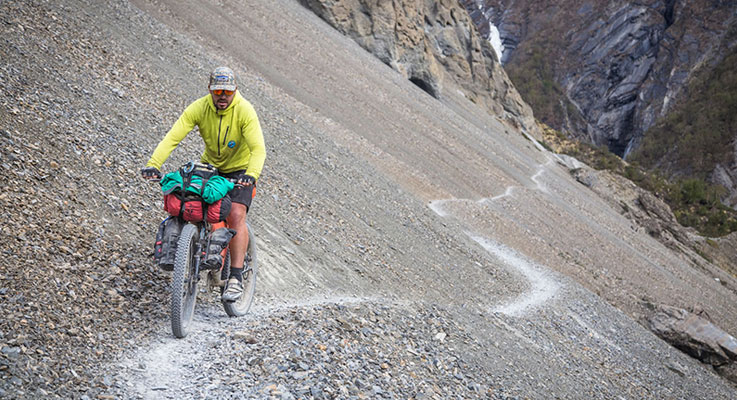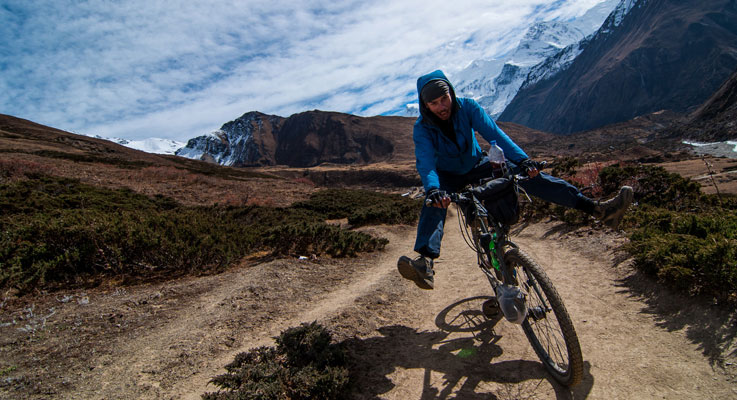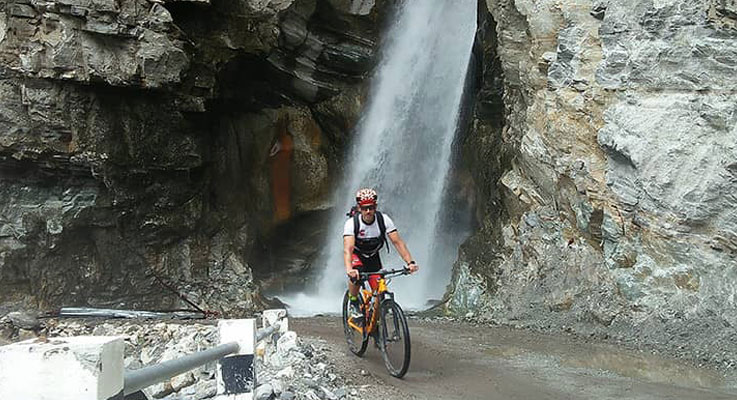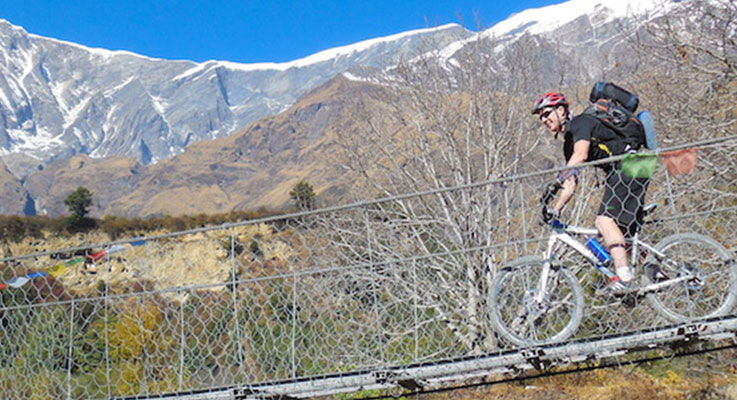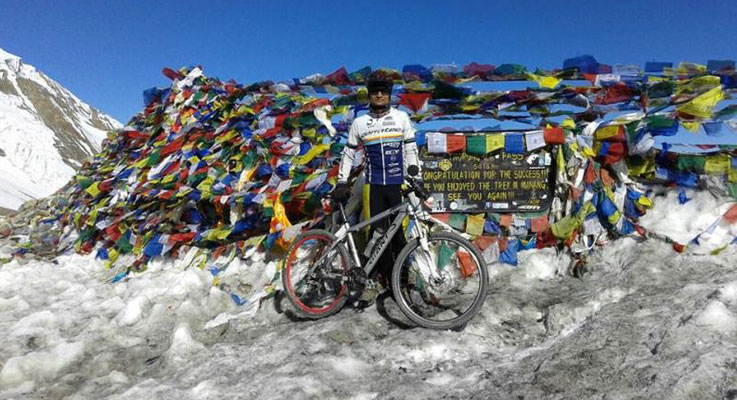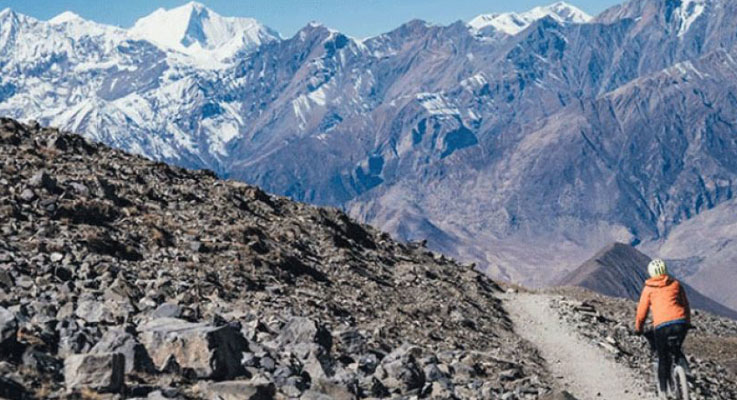-
Day 1
Arrival in Kathmandu. Some sightseeing and trip briefing
Our staff will welcome you at the Tribhuwan International Airport upon your arrival and transfer you to the hotel on a private vehicle. The evening can be spent exploring Thamel, a tourist hub offering numerous bars, shops and restaurants, as well as Basantapur, which gives you an instant taste of Nepali life. Later in the hotel, we will brief you on trip details, safety and preparation for the adventure.
-
Day 2
Drive from Kathmandu to Besi Sahar. Bike from Besi Sahar to Khudi
We set off on a 5-hour drive in the morning to the town of Besi Sahar, the starting point of our trip. You can observe the local way of life, bustling local markets, the mighty Trishuli River and the distant mountains during the drive. When we reach Besi Sahar, we will ready our bikes and ride to Khudi. The first views of the Annapurna range will be visible during the trip, with the Marshyangdi River (also called Khudi River) gushing below. The traditional Nepalese way of life will leave you enchanted during 22 kms of riding today in mostly jeep tracks. This is a great prelude to the exciting adventure in the days to follow.
-
Day 3
Bike from Khudi to Tal
Leaving Khudi, we follow jeep tracks again and reach the entry gate of the Manang district en route. There are some steep and rocky sections here where we’d have to carry or push he bikes. The region starts to get more remote and gives us the true taste of the marvelous Nepali life composed of different cultures. There is a fantastic waterfall along the way and you should definitely enjoy the chilling water here.
-
Day 4
Bike from Tal to Chame
Riding the ascending trails through pristine forests and passing Buddhist prayer walls, we ride along marvelous green fields of corn, barley and potatoes. There is some pushing and carrying involved here, especially till the village of Danagu, from where the trail is more rideable also giving you better glimpses of the Himalayas. After almost 30kms of riding in a mix of jeep tracks, single tracks and rocky trails, we reach the district capital of Manang, Chame, where we can relax along the hot spring set on the Marshyangdi River. We’ll explore the region and taste products from a popular bakery and get in touch back home from an Internet café. The majestic views of Lamjung Himal, Annapurna II and Annapurna IV mark our stay at Chame.
-
Day 5
Bike from Chame to Manang
As we climb higher, the increase in altitude can be felt with the effect you experience while riding. With trails that run through forests and a narrow valley, we cross several suspension bridges en route. There are enormous massifs along the way, which is the heart of the Annapurna region. The trails run through a wide valley, passing through Humde, a village with one of the highest commercial airports in the world. There are a number of monasteries along the way, and the famous Barga Monastery is worth a visit. Local peaks are another spectacle that will definitely draw your attention – there are several peaks over 4,000m. The change in landscape and vegetation is very marked in Manang, the ancient and mystifying village with a very intriguing culture and lifestyle.
-
Day 6
Rest day at Manang
In order to acclimatize to the higher altitude, we’ll spend the day at Manang, situated at 3,540m. The air things out at this point, and it is necessary to let our bodies adjust to the change so as to avoid high altitude sickness. Manang has plenty to offer for sightseeing, so today we’ll explore this amazing village, visit Hundred Rupees Lama Monastery and hike to Gangapurna Lake. We’ll check the bikes and make sure it’s ready for more adventure.
-
Day 7
Bike from Manang to Yak Kharka
We leave Manang through a maze of narrow alleys and medieval houses of Manang. As we climb up steadily to the village of Khusang, we say goodbye to Marshyangdi Valley and following the trails leading to Jarsang River, we reach Yak Kharka. Despite rideable trails, the higher altitude takes effect and pushing the pedals become an effort. We’ll take it easy and ride at a comfortable pace, enjoying the marvelous beauty of the otherworldly landscape and the giant Himalayan mountains. The settlements are sparser in this region and along the way we can encounter yaks in large numbers grazing here, as well as an old mani, a Buddhist prayer-engraved wall. After the day’s hard work riding mostly through single tracks, we reach Yak Kharka village in early afternoon.
-
Day 8
Bike from Yak Kharka to Thorung Phedi
Today is a climb to Thorung Phedi through trails that first drop and cross Jorsang River at 4,310m, and then ascend steeply. We ride through the picturesque village of Tenki Manang from where you get stunning views of Annapurna, Gangapurna and Tilicho. Along the way, we cross several small wooden bridges over streams and ride through a narrow path heading towards Thorung Phedi. “Phedi” means base of a hill or a mountain; and Thorung Phedi is the base of the massive Thorung La Pass, which we cross the next day.
-
Day 9
Bike from Thorung Phedi to Muktinath, via Thorung La Pass
We start very early in the morning to dodge high winds to reach the top of the Thorung La Pass, at an altitude of 5,416m. The feeling of accomplishment at the pass is one to savor for a lifetime. Marvel on the panoramic vista of a chain of virgin snowcapped mountains far and beyond you see from this altitude. From the pass, we head down to Muktinath, while coming across trekkers and pilgrims flocking from as far as India on their way to this revered Hindu temple. Once at Muktinath, we’ll spend some time exploring the religious site and see the eternal flame that burns on natural gas source. “Mukti” means liberation and “nath” means a holy temple, so Muktinath is considered to be a temple of soul liberation. Besides Hindu hermits and pilgrims we’ll see Tibetan traders as well.
-
Day 10
Bike from Muktinath to Tukuche
From Muktinath we ride along a very enjoyable downhill track descending to the Kaligandaki River valley floor. We’ll make a quick pit stop at Marpha, a village with legendary apple orchards. Make sure to taste some Marpha Brandy and a range of apple products like apple pie and dried apple skin. We call it a day at Tukuche village, an ancient Thakali tribe settlement, and spend some time exploring the region and learning about the culture and history of the village. Tukuche lies right beneath the Tukuche peak and Dhaulagiri, with amazing views of Mt. Nilgiri and icefalls of Dhaulagiri’s east face.
-
Day 11
Bike from Tukuche to Tatopani
We begin riding from Tukuche to Tatopani through some fantastic downhill sections. Tatopani translates to “hot water” and rightly so, the hot springs at Tatopani are quite a treat. This is a fabled place to relax your mind and body, so pamper yourself after a great day of biking in this fantastic region. Located besides the banks of the Kali Gandaki River, the hot dip amidst the surrounding natural beauty in Tatopani will definitely help to unwind your muscles.
-
Day 12
Bike from Tatopani to Beni. Drive from Beni to Pokhara
After a relaxing time at Tatopani, we ride for about 1.5 hours on jeep tracks to reach Beni, a small but vibrant market town. We’ll spend some time exploring the town and then drive back to Pokhara on a 4-hour drive. It’s a bumpy drive and you can enjoy the scenic views you get along the away. Once we reach Pokhara, we can do some boating on the Phewa Lake and have a pleasant time reflecting on our thrilling adventure in the Annapurnas.
-
Day 13
Drive from Pokhara to Kathmandu. Farewell dinner in the evening
Our staff will take you to the bus station for an early morning drive to Kathmandu, and transfer you to the hotel. We’ll have some time for some shopping in late afternoon. In the evening, you’re invited for a farewell dinner at a traditional Nepalese restaurant which hosts cultural performances, and you’re more than welcome to join the merry. We toast a round or two of locally brewed drinks to celebrate our trip achievement and to good health!
Holidays should never have an ending date. So extend your trip and whet your appetite for adventure with a host of activities including trekking, bungy jumping, mountain flight, rafting, hiking, Chitwan jungle adventure, and Lumbini heritage trip. These can be arranged before or after the biking adventure.
-
Day 14
Flight departure from Nepal
The trip concludes today. Our staff will drop you off at the Tribhuwan International Airport and wish you bon voyage for onward journey.

